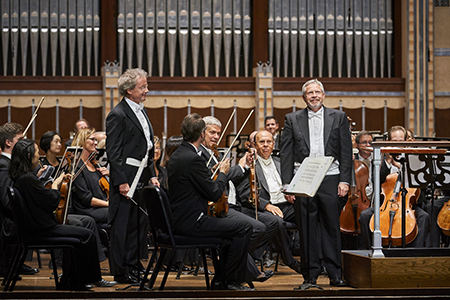by Daniel Hathaway

Sweltering conditions aside, the Orchestra turned in distinguished performances of challenging new works by Jeffrey Rathbun and Hans Abrahamsen, and an audience-pleasing Tchaikovsky standard. The sold-out concert was the Orchestra’s latest appearance on the Oberlin Artist Recital Series, where it has performed at least annually since 1919.
Jeffrey Rathbun has stepped out of his assistant principal oboe chair on several occasions to hear his own compositions played by the Orchestra. His latest, Pantheon, follows Daredevil (1995), Three Psalms for Jerusalem (1998), and Motions for cellos (2000).
The latest work is a commission in celebration of the Orchestra’s centennial. In an interview with this publication, Rathbun said, “I proposed writing a 10-to-20-minute piece that would show off my orchestra colleagues — just something that I could contribute in my small way to the anniversary, which is so meaningful to all of us.”
In his 11-minute, overture-like piece, Rathbun succeeded in showing off the Orchestra’s prowess as an ensemble, as well as the depth of talent it offers among its sections and soloists.
Pantheon gets underway with low rumbles, high tweets, and a crescendo into a massive string section unison. The textures calm down in a middle section that features idiomatic solos for clarinet, bass clarinet, oboe (joined by piano), English horn, and violin, before the character of the music swells into a kind of cinematic splendor. As the music subsides once again, mallets join solo bassoon before the piece begins to fade amid an ostinato-like figure.
The effect was festive, the musical language accessible, and the audience gave Jeffrey Rathbun, Pantheon, and the Orchestra an enthusiastic round of applause.
Only one of French pianist Alexandre Tharaud’s hands was involved in Danish composer Hans Abrahamsen’s Left, alone, a work co-commissioned by four European orchestras for performances in 2016 (Tharaud played its world premiere with the WDR Symphony Orchestra in Cologne).
Unlike other single-hand concertos, this one wasn’t directly inspired by a performer with a disability, although Abrahamsen himself was born with a condition that impacts two fingers on his right hand.
The concerto — which rarely puts the soloist in a traditional position of prominence — begins remarkably like Rathbun’s piece, with rumbles in the bass range of the orchestra answered by shrill responses from the treble instruments. As the piece continues, its six movements vary wildly in style and texture.
Cleveland audiences who heard Barbara Hannigan’s performances of Abrahamsen’s song cycle let me tell you under Welser-Möst in 2016 already have some experience with the composer’s sparse yet subliminally complicated textures. But Left, alone sometimes features surprising voids between musical events, as in the second movement, when the piano dialogues pointilistically with claves in the percussion.
A scherzo, an eruption, a succession of long, static notes, and a swarm of killer bees ensues — Abrahamsen always has new ideas hiding just around the corner. Whether called upon to play active material, isolated notes, tap on the piano, or pluck its strings, Alexandre Tharaud was intensely involved in the piece, adding remarkable amounts of body English to even the simplest tasks.
Here, the audience response was on the tepid side, or perhaps listeners were just wilted by the heat. On first hearing, Left, alone inspired admiration for its obvious craftsmanship.
After a bit of fresh air for performers and audience alike, Welser-Möst and the Orchestra ended the concert with a suite from Tchaikovsky’s Swan Lake. Without a tutu in sight, ears were left to imagine the scenario through the music alone. Not a difficult task with a tunesmith as skilled as this composer, and individual orchestra members — including violinist Peter Otto, oboist Frank Rosenwein, clarinetist Afendi Yusuf, and trumpeter Michael Sachs — ably took the spotlight in lieu of solo dancers. Welser-Möst paced the dances with a sure hand, giving harpist Trina Struble ample space to luxuriate in her prima arpa role, but perhaps urging some tempos beyond danceability. The Orchestra was sonically magnificent, and the violins nailed complicated passages single-mindedly. The ovation raised the temperature in Finney Chapel at least ten degrees higher.
Photos of The Cleveland Orchestra in Finney Chapel at Oberlin (last season) and in Severance Hall (on September 20) by Roger Mastroianni.
Published on ClevelandClassical.com September 25, 2018.
Click here for a printable copy of this article





